(172 products available)












































































































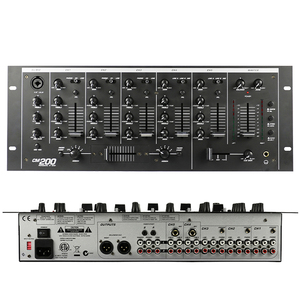
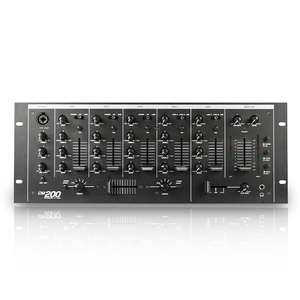
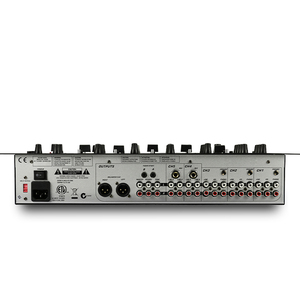
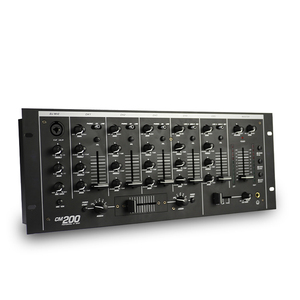
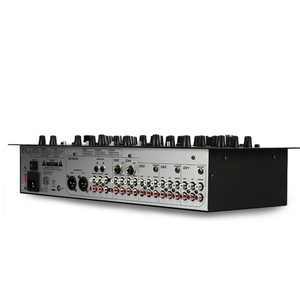





























































































Mixing desks come in various types, each designed for specific applications and preferences. Understanding the different types is important when selecting a mixing console desk that best suits one's needs, whether in professional studios, live sound environments, or home recording setups.
Analogue Mixing Console Desks
Analogue mixing desks are traditional workhorses in audio mixing. These desks use analogue circuitry for signal processing, which gives sound a warm, vintage character preferred by some audio professionals. Analogue mixing console desks are straightforward in their design and functionality, allowing for direct manipulation of audio signals. The knobs and faders provide a tactile experience that many users find satisfying and effective. While digital technology is prevalent, analogue desks remain crucial in studios focusing on warmth and character in their recordings.
Digital Mixing Console Desks
Digital mixing console desks have become widely adopted due to their precision and versatility. These desks employ digital signal processing (DSP) for audio mixing, providing extensive features such as automatic mixing, preset recall, and seamless integration with digital audio workstations (DAWs). The main advantage of these desks is their flexibility — users can save and recall settings efficiently, which is vital for live performances and studio sessions. Furthermore, digital desks are generally lighter and more compact, making them ideal for portable applications. However, some purists still favour analogue desks for their warmth and reliability.
Hybrid Mixing Desk
Hybrid mixing desks blend analogue and digital technologies, aiming to combine the best of both worlds. These desks often use analogue circuitry for input and basic processing, then convert to digital for recording and effects processing. This allows studios to benefit from the warmth and character of analogue mixing while taking advantage of digital precision for recording and editing. Hybrid desks can be more expensive to operate and maintain than their fully analogue or digital counterparts, though they are excellent for businesses that require flexibility in their mixing processes.
In-Line Mixing Desks
In-line mixing desks are designed for complex audio routing and are commonly used in professional broadcast and recording studios. These desks have two track channels — one for monitoring and one for recording. This complexity allows engineers to manage multiple audio feeds efficiently. In-line desks can be cost-effective by reducing the number of required channels, as both monitoring and recording can use the same channel. However, their intricate design can be daunting for beginners.
Component Mixing Desks
Component mixing desks are modular systems where different parts of the mixing console, such as the channel strips, power supply, and routing modules, are separate, allowing for a custom setup. This flexibility is favoured by high-end professionals who want to tailor their mixing system to specific needs. Channel strips can be changed or upgraded, and the desk's design can evolve as technology or user requirements change. These systems, while offering unparalleled customisation, are more expensive upfront and require more installation and maintenance work to function correctly.
Channel Count and Configuration
The number of channels on a mixing console desk determines how many audio sources one can manage simultaneously. Desks with more channels help in large-scale productions where many microphones, instruments, and other audio feeds are in use. The configuration of channels is just as essential. For example, some channels may be equipped with microphone preamps, while others may feature line inputs or digital connectivity. Choosing the right configuration ensures all sources connect easily without needing extra hardware.
Input and Output Connectivity
A good mixing console desk will have various connections, like XLRs, quarter-inch jacks, and digital interfaces. These are vital for connecting microphones, instruments, monitors, and external hardware. Desks with greater I/O numbers remove the requirement for additional gear, which can introduce latency or reliability issues. Digital connections like ADAT or Dante are important for those working with deeper digital audio systems. The desk should meet all audio requirements to ensure seamless system connectivity.
Auxiliary Sends and Returns
Auxiliary sends and returns are useful in mixing for effects processing and monitor mixing. Auxiliary sends allow engineers to send a portion of the audio signal from any channel to an external effects unit or monitor mix. Having multiple auxiliary sends and returns per channel increases flexibility. It also allows the on-the-fly addition of effects like reverb or delay. These features are fundamental for live sound events, as quick adjustments are crucial.
Equalization and Signal Processing
Equalization helps to refine audio quality by adjusting frequency levels of each channel. Mixing console desks have powerful EQ sections with several frequency bands for more intricate audio adjustment. Advanced models possess parametric equalizers that give one control over frequency, gain, and bandwidth. Some desks even have built-in digital signal processing (DSP) options, like compression or reverb, which allow basic cleanup and mixing before sending audio to recordings or amplifiers.
Automation and Display
A lot of modern desks permit setting recalls and mixing levels using automated control. This helps after initial setup — one can store and switch between different mixing configurations. Desks with larger screens show more information, thus simplifying and speeding up the process of complex mixing. Real-time monitoring of levels and other important factors helps ensure that the desk is operated at an optimal level during both live performances and studio usage.
Studio and Broadcasting Industry
Mixing console desks are important tools for professional recording studios and broadcasting. Good quality consoles provide detailed audio control, which directly impacts recording quality. Strong brands in the audio industry seek high-end mixing desks, as these consoles help with complex tasks and run many channels. As the content creation market grows, mixing desks are tremendously important in producing superior music, podcasts, and video content.
Live Sound and Events
Big live events, concerts, and corporate gatherings rely on solid mixing consoles for professional sound. Demand grows for desks that handle many live inputs, contain effective FX, and interface easily with PA systems. Good consoles provide stability and flexibility for rapid mixing in dynamic environments. Companies that supply equipment for major tours and events seek desks that perform under pressure, as one faulty piece can disrupt the whole show.
Education and Training Facilities
Mixing desks are critical equipment for audio engineering schools and training programs. Students learn practical skills on different consoles, shaping their mixing techniques. Schools pick their desks carefully to reflect industry standards. Having the latest equipment attracts students, as modern consoles provide a comprehensive understanding of mixing in professional settings. The selection of desks impacts graduates' job readiness and skill development in audio engineering.
Corporate and Communication Industries
Corporate media, marketing agencies, and communication firms use mixing desks for video production and live streaming. Good desks facilitate smooth audio mixing for video content and presentations, which affects production speed and audio quality. In-house and agency studios need consoles that are flexible and easy to use for quick content creation for social media and advertisements. Audio quality is critically important in business environments where sound impacts clarity and professionalism in communication.
Home Studios and Content Creators
Mixing desks appeal to a growing number of independent creators, podcasters, and YouTubers who build home studios. Many budget-friendly consoles suit small setups, providing professional-level mixing. Detailed audio control improves production quality for online content, attracting viewership and engagement. Desks that connect directly to streaming tech simplify the home studio process. As demand rises, more affordable options help newcomers enter the field and drive value, enabling entry without needing expensive pro-console setups.
Assess Requirements
One needs to start by defining the use of the console and how many inputs are needed. For big live mixing or recording, go for a console with lots of channels. For smaller jobs or home studios, a compact desk will do. Check if analogue, digital, or hybrid desktops are more suited to one's workflows.
Sound Quality
The preamps and processing power of the mixing console desks always impact the sound level. Choose a desk with solid preamps for clearer audio. Mixing desks should give the audio warmth and clarity based on the user's taste and style.
Budget And Brand Reputation
Prices vary widely based on features and quality, so set up a budget first. When it comes to audio gear, some brands have more expertise than others. They will provide support and updates for their products. Ensure there are funds for optional extras like cases or additional hardware for the console to protect the investment.
Testing The Interface
It is important to try out the layouts and styles of the controls whenever possible. One needs to ensure that the knobs, faders, and displays are simple to use, as this would make mixing quick and efficient during live events or intense sessions.
Digital Integration
If going for a digital console, make sure one understands how well it connects with DAWs and other gear. Having interfaces that connect digitally cuts down setup time and brings in a more seamless recording and performance flow.
Analogue mixing desks work with traditional circuitry, giving sound a warm, vintage feel. Digital mixing desks, however, use computer technology for mixing, offering more precise control and flexible features like memory saving. Digital desks are lighter, easy to connect with software for recording, and usually have advanced effects. While analogue is favoured for its warmth by those in the recording studio, digital is often picked for live sound because of its speed and accuracy.
Hybrid consoles merge the warmth of analogue with the precision of digital, letting studios enjoy both worlds. They allow analogue signal processing, then switch to digital for recording and effects, which is quite useful for systems trying to maintain that classic audio quality while utilising modern efficiency. With so many projects needing flexibility, these versatile desks are gaining popularity.
The choice depends on use, sound quality, budget, and ease of interface. One needs to know how many inputs are needed, socket types to have available, and whether analogue or digital is preferred for the sound. Clean faders and good displays are simple mixes in live situations. Costs vary, but getting a reliable brand with proven support is important.
Big live events, recording studios, schools teaching audio, video production houses, and content creators all need good mixing desks. They rely on consoles for detailed control over sound, which is crucial for professional results in recording, broadcasting, and live performances.
Yes, smaller home studios and podcasters can find mixing desks with fewer channels that also handle analogue and digital work for better prices. These desks are still powerful and will suit entry-level or smaller setups while addressing the demand for quality sound desk experiences.